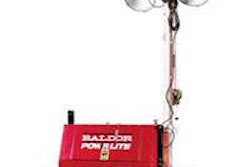
by Daniel Brown, Contributing Editor
With workability, environmental benefits and solid performance reports,Reclaimed Asphalt Pavement — RAP — is becoming a bigger part of the mix.
It’s a trend that’s sweeping the nation: using more reclaimed asphalt pavement (RAP) in hot-mix asphalt. RAP is also making inroads into warm-mix asphalt.
 Astec’s foamed asphalt attachment makes warm mix, which will enhance the workability of high RAP mixes.
Astec’s foamed asphalt attachment makes warm mix, which will enhance the workability of high RAP mixes.
Since 2007, about half the states, 24 to be exact,* have increased the allowable percentages of RAP in their asphalt pavements. And using RAP can save states a lot of money.
To mill, haul and process RAP costs only a fraction of the cost of virgin mixtures. So RAP allows contractors to produce a lower cost hot mix and pass along savings to owner agencies.
“States are allowing more RAP to guard against future high fluctuations in the price of asphalt binder,” says David Newcomb, vice president of research and technology for the National Asphalt Pavement Association (NAPA). “Plus, RAP is more environmentally friendly. And states have looked at the performance of mixes with higher RAP contents and concluded that RAP doesn’t detract from the quality of the asphalt.”
RAP primarily comes from rehabilitation of existing roadways or parking lots. Typically it is trucked from a milling machine to a stockpile at an asphalt plant. RAP helps reduce the cost of hot mix because the aggregates in the recycled material have already been coated with asphalt.
RAP can be added directly to hot-mix asphalt at the mixing plant in amounts ranging from 10 percent to 50 percent or more by weight of the mix. Properly designed and constructed, pavements with RAP will last as long or longer than roadways built with virgin materials, says Kent Hansen, director of engineering for NAPA
More RAP = lower bid prices
Contractors using more RAP can cut their bid prices for hot-mix asphalt.
The total cost of milling RAP from a project, hauling it to an asphalt plant, and crushing and screening is typically between $6 and $10 per ton, says Randy West, director of the National Center for Asphalt Technology (NCAT) at Auburn University in Alabama. Virgin aggregate costs range from $10 to $25 per ton, depending on the region of the country. In 2008, virgin asphalt prices in 2008 jumped from about $350 to $800 per ton. In 2009, liquid binder stabilized at around $410 per ton.
For example, a virgin mix (5-percent binder but no RAP) with $15-per-ton aggregate and $410-per-ton asphalt binder costs about $34.75 per ton for hot mix materials. (The materials cost is 0.95 x $15 + 0.05 x $410 = $34.75)
By contrast, with a mixture of 5 percent asphalt binder and 20 percent RAP that costs $8 per ton to process, the materials for the RAP mix cost about $29 per ton — more than a 16-percent savings over the $34.75-per-ton virgin mixture. As RAP content and virgin binder costs increase, so do the savings.
So when liquid binder prices spiked in 2008, West says the industry recognized that the best way to keep hot mix asphalt costs in check was to increase RAP contents. The other big motivation for higher RAP contents has been the sustainability movement. Recycling more today means using less of the earth’s non-renewable natural resources.
High RAP contents
Although many agencies were restrictive on RAP usage in the past, particularly for surface layers, there is a growing trend to allow higher RAP contents. The national average RAP content for surface mixtures is about 15 percent, and it’s about 20 percent for base and intermediate courses, says West. When asphalt recycling began in the late 1970s, RAP contents of more than 50 percent were used on some projects.
Florida provides a good example of increasing RAP usage. When binder prices jumped in 2008, Florida boosted the percentage of RAP allowed in surface courses to 15 percent, up from zero, says Jim Musselman, a Florida state bituminous materials engineer.
In the next year, the state raised the percentage again, to 20 percent.
But the increase came with qualifications. Florida has a problem with local aggregates that polish on the surface and don’t provide good friction characteristics. So when the state raised the RAP percentages allowed in surface courses, it also required the virgin aggregates to consist of 60 percent granite. The granite is imported from Georgia or from Nova Scotia.
“We use a very large volume of RAP in Florida,” Musselman says. “Historically, it’s accepted practice in every layer except surface courses. We took a big step up to allow it in surface courses. Our average RAP use today is 23 percent.”
A few pavement failures with high RAP contents decades ago likely caused some agencies to take a very cautious stance on RAP usage. “Failures typically are not well investigated or documented and so we often don’t learn the real causes,” West says. “Some agencies want more performance data on higher-RAP mixes; others want to wait on more guidance on how to select the right grade of virgin binder.”
Today’s RAP technology is more advanced than when the failures occurred. “A couple of new technologies are coming into practice to make these higher percentages of RAP more successful,” West says. One is the fractionation of RAP, which separates the material into two or more stockpiles based on the size of the RAP particles. It’s becoming more common to separate RAP into a coarse pile, with particles of more than 1/2-inch or 3/8-inch in size, and a fine pile with particles of less than one-half of an inch. That lets contractors use fine RAP in finer asphalt mixtures and coarse RAP in coarse mixtures.
Mixing RAP and WMA for compactability
“Second is the combination of warm-mix asphalt technologies with high RAP contents,” West says. Warm-mix asphalt technology does not necessarily allow one to use higher percentages of RAP. However, mixes with high RAP contents can be difficult to place and compact – but a WMA technology can help with compactability.
“The advantages of the RAP and WMA combination include enhanced workability of high RAP mixes, big economic savings, plus the triple environmental benefits of reduced (plant) emissions,, reduced energy demand, and conservation of natural resources,” says West. (Warm mix asphalt results in a mixture that is about 240 to 270 degrees Fahrenheit, not the 300 degrees Fahrenheit used for conventional hot-mix asphalt.)
When a conventional hot mix plant runs RAP, you have to push up the virgin aggregate temperature to 500 or 600 degrees Fahrenheit to heat the RAP that is being added. But with WMA technology, you don’t heat the mixture as hot. That means you don’t drive off the light oils from the virgin binder or the RAP. Using warm mix technologies provides a better film thickness of binder on the aggregate, and the RAP is not scorched in the process.
Test track results
On the NCAT Test Track in Alabama, where accelerated loading tests are run on various asphalt mixtures, high RAP pavements have turned in some excellent rutting results. Basically the results show that the more RAP a mixture contains, the less rutting you’ll get. For example, less than 9 million equivalent single axle loadings (ESALs) a 20-percent-RAP mixture using a PG 67-22 binder showed a rut depth of 8.6 millimeters. By contrast, a 45-percent-RAP mixture with PG 76-22 binder showed only 0.5 mm of rut depth after 9 million ESALs.
 LoJac Enterprises Inc., of Tennessee, ran 50 percent RAP in 9,000 tons of a binder course and 30 percent RAP in 6,000 tons of surface course mixture for a demonstration project.
LoJac Enterprises Inc., of Tennessee, ran 50 percent RAP in 9,000 tons of a binder course and 30 percent RAP in 6,000 tons of surface course mixture for a demonstration project.
NCAT’s West explains that as RAP percentages increase, the binder stiffness also increases. And stiffer binders are more resistant to rutting. West does, however, express some concern with cracking of high-RAP mixtures.
Field performance results on cracking tend to vary, he says. In some cases the virgin mixes have performed better than RAP mixes and in others, the mixes with RAP have performed better than virgin mixes in terms of cracking. “A properly selected virgin binder can mitigate issues with cracking,” West says.
 Fractionating RAP helps a producer to better control the sizes of the material.
Fractionating RAP helps a producer to better control the sizes of the material.
NAPA’s Newcomb says several factors will contribute to success with increased percentages of RAP. “Today we have better controls and management of RAP stockpiles and hot mix plants in general,” says Newcomb. “We have better plant emissions controls, better heat distribution in the mixing drums, and better ways to size the RAP and feed it into the drums.” v
Cold RAP Makes Green Pavement
The first portable cold mix plant in North America permits Albuquerque Asphalt Inc., of Albuquerque, N.M., to build a strong road base material using cold reclaimed asphalt pavement (RAP) and a combination of binder materials.
Albuquerque Asphalt recently gained approval by the city of its name to use the material, called Q Base, in street base construction, says Robert Wood, president of the company. Q Base is aimed to dovetail with the city’s Albuquerque Green Q initiative. Q stands for quality, and also is a play on the letter Q appearing twice in the city’s name.
To make the material, Albuquerque Asphalt bought a Wirtgen KMA 220 portable cold mix plant. The plant uses a pugmill to incorporate 1.5 percent hot performance grade asphalt binder, which is foamed into crushed RAP along with a small amount of water and 1.0 percent Portland Cement. Wirtgen calls the material Green Mix, because the aggregate is made of 100 percent recycled materials. The RAP is crushed to ¾-inch (0.75) minus size.
 The Wirtgen KMA 220 portable cold mix plant can produce 220 tons per hour of asphalt base material using virgin and/or reclaimed materials including excavated road base, RAP, or crushed recycled concrete.
The Wirtgen KMA 220 portable cold mix plant can produce 220 tons per hour of asphalt base material using virgin and/or reclaimed materials including excavated road base, RAP, or crushed recycled concrete.
“With that mix design we achieve a structural coefficient of 0.3 per inch of thickness,” says Wood. He says his specification calls for attaining 1,625 pounds of Marshall stability – and the lowest actual test number for the material is 1,800 pounds. “And we’ve achieved some tests of well over 2,000 pounds,” Wood says.
Albuquerque Asphalt has gained preliminary approval from the New Mexico DOT to use Q Base as an accepted road base material. “And we’ve put down 10,000 tons for Bernalillo County, where Albuquerque is located,” Wood says.
On a recent county project called La Vega Street, the design called for 3 inches of conventional hot mix asphalt (HMA) to be placed over 6 inches of untreated gravel base. “We ran an equivalent structural number with Q Base, and came up with 1.5 inches of HMA over 4 inches of Q Base,” Wood says. “But we actually placed 2 inches of HMA over 4 inches of Q Base.
“We’re very excited about Q Base,” Wood continues. “And once these government engineers see this material, they’re excited about it. It’s a wonderful material with an exciting future.”











